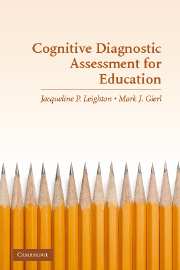Book contents
- Frontmatter
- Contents
- List of Contributors
- PART I THE BASIS OF COGNITIVE DIAGNOSTIC ASSESSMENT
- 1 Why Cognitive Diagnostic Assessment?
- 2 The Demand for Cognitive Diagnostic Assessment
- 3 Cognitive Modeling of Performance on Diagnostic Achievement Tests: A Philosophical Analysis and Justification
- 4 Test Validity in Cognitive Assessment
- PART II PRINCIPLES OF TEST DESIGN AND ANALYSIS
- PART III PSYCHOMETRIC PROCEDURES AND APPLICATIONS
- Author Index
- Subject Index
- References
2 - The Demand for Cognitive Diagnostic Assessment
Published online by Cambridge University Press: 23 November 2009
- Frontmatter
- Contents
- List of Contributors
- PART I THE BASIS OF COGNITIVE DIAGNOSTIC ASSESSMENT
- 1 Why Cognitive Diagnostic Assessment?
- 2 The Demand for Cognitive Diagnostic Assessment
- 3 Cognitive Modeling of Performance on Diagnostic Achievement Tests: A Philosophical Analysis and Justification
- 4 Test Validity in Cognitive Assessment
- PART II PRINCIPLES OF TEST DESIGN AND ANALYSIS
- PART III PSYCHOMETRIC PROCEDURES AND APPLICATIONS
- Author Index
- Subject Index
- References
Summary
In this chapter, we explore the nature of the demand for cognitive diagnostic assessment (CDA) in K–12 education and suggest that the demand originates from two sources: assessment developers who are arguing for radical shifts in the way assessments are designed, and the intended users of large-scale assessments who want more instructionally relevant results from these assessments. We first highlight various themes from the literature on CDA that illustrate the demand for CDA among assessment developers. We then outline current demands for diagnostic information from educators in the United States by reviewing results from a recent national survey we conducted on this topic. Finally, we discuss some ways that assessment developers have responded to these demands and outline some issues that, based on the demands discussed here, warrant further attention.
THE DEMAND FOR COGNITIVE DIAGNOSTIC ASSESSMENT FROM ASSESSMENT DEVELOPERS
To provide the context for assessment developers' call for a revision of contemporary assessment practices that, on the whole, do not operate within a cognitive framework, we offer a perspective on existing CDA literature, and we outline the differences between psychometric and cognitive approaches to assessment design. The phrases working within a cognitive framework, cognitively principled assessment design, and cognitive diagnostic assessment are used interchangeably throughout this chapter. They can be generally defined as the joint practice of using cognitive models of learning as the basis for principled assessment design and reporting assessment results with direct regard to informing learning and instruction.
- Type
- Chapter
- Information
- Cognitive Diagnostic Assessment for EducationTheory and Applications, pp. 19 - 60Publisher: Cambridge University PressPrint publication year: 2007
References
- 42
- Cited by



